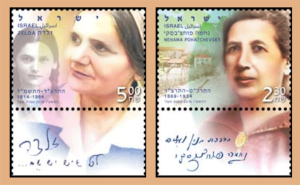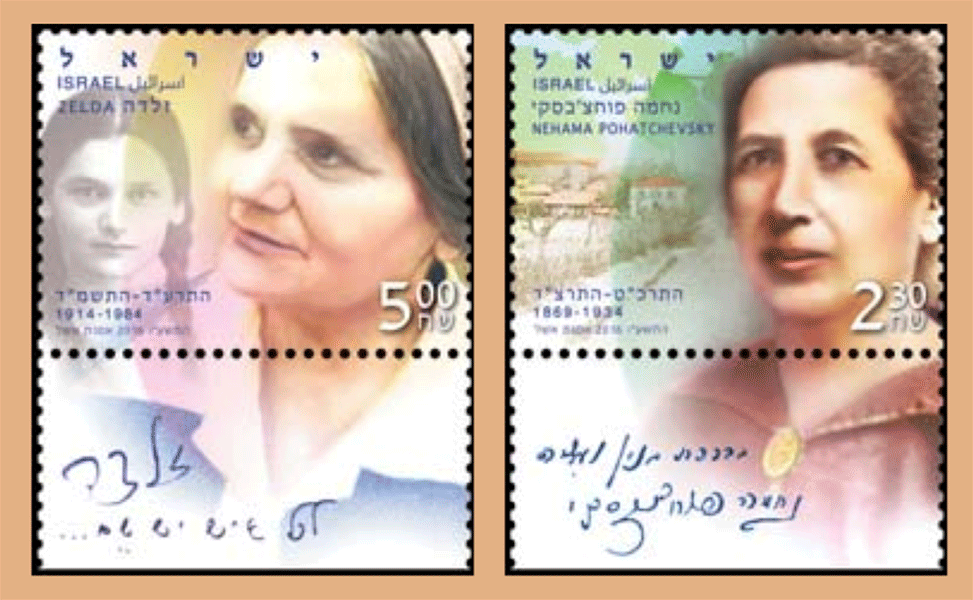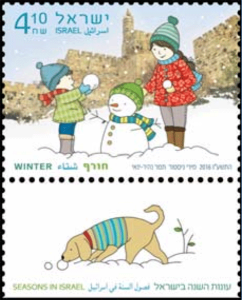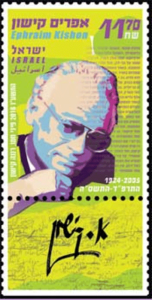Nehama Pohatchevsky, Zelda
 The issue date is February 9, 2016.
The issue date is February 9, 2016.
Early signs of women’s aspirations for gender equality in Eretz Israel were apparent as far back as the First Aliyah, as some women chose to take part in public affairs or nonconventional professions. Although the pages of history have not granted them their proper place – they operated in a world of preconceptions and discrimination against women, their fight for self-realization and equal opportunity cleared a path and inspired others.
The State of Israel embraced equality as a core principle early on, and just three years after the establishment of the State the Knesset passed the Women’s Equal Rights Law of 1951, guaranteeing equal treatment of women and men.
Women have yet to be fully included in society’s most influential bodies, but the efforts of these pioneering women set a quiet social revolution in motion, furthering gender equality and changing our society.
Nehama Pohatchevsky
1869, Brest, White Russia – 1934, Rishon LeZion, Israel
Author Nehama Pohatchevsky, known as Nefesh (“soul” in Hebrew, based on her maiden name, Nehama Feinstein) wrote articles in Hebrew as a youth in Russia and corresponded with poet and scholar Yehuda Leib Gordon (Yalag,Y.L.G). Her desire to immigrate to Eretz Israel was realized in 1889, following her marriage to Michel Pohatchevsky of Rishon LeZion.
Writing was in her blood. Nehama Pohatchevsky wrote about the lives of the pioneers and about building the national Jewish homeland in Eretz Israel, focusing on the struggles of the “new woman” in the newly developing Jewish community in the ancient homeland and her position in the family and in society. Thus she is known as the first female Hebrew author of Eretz Israel.
Life in the agricultural community was difficult during the First Aliyah and she worked hard raising her children, on the family farm and in the community. Although her two eldest sons passed away in infancy, she raised her son and daughter Asahel and Efrat. Nefesh was a pioneer and a woman ahead of her time. While working as a farmer and an author, she was also a public activist who fought for Hebrew labor and for instilling the Hebrew language, and also promoted equal rights and voting rights for women. She founded and was active in the Bikur Cholim Association, served as a mediator in the Rishon LeZion Magistrates Court, assisted new immigrants from Yemen and was a member of the Moshava Committee and the National Committee. She published articles and stories. Her collections of stories BeYehuda HaHadasha (In the New Yehuda) (1911) and BaKfar UbaAvoda (In the Village and at Work) (1930) were published in her lifetime, while her novel BaMidron (On the Decline) was published 70 years after her death, in 2004.
—Dr. Ora Asahel Silverstein
Zelda
1914, Ukraine – 1984, Jerusalem
Zelda Schneerson-Mishkovsky is one of the most significant and beloved Hebrew poets of our generation. Tens of thousands of copies of her collected poems from the six books published in her lifetime have been printed to date. Her poems are read and adored by an extremely broad audience: young and old, religious and secular, people from different places and from varying spiritual worlds.
Zelda was a direct descendant of the Lubavitcher Rebbes. She immigrated to Israel as an only child with her parents and grandfather in 1925. Several months later, her grandfather and father both passed away in Jerusalem. Although Zelda published poems and articles in newspapers and magazines over the years, her first collection of poems P’nai (Leisure) did not appear until 1967, when she was 53 years old. The book achieved immediate success among critics as well as a broad section of the reading public.
Thirty years after Zelda’s death in Jerusalem, her friends published a book of her unpublished writings and drawings, Tzipor Ahuzat Kesem (An Enchanted Bird). As writer and critic Dror Burstein remarked in his review of the book (Haaretz, July 2014): “These pages confirm Zelda’s place as one of the most important spiritual figures in Israeli poetry of the 1960’s and 1970’s and far beyond.”
Description of the Stamps and First Day Covers Nehama Pohatchevsky
Nehama Pohatchevsky
Stamp: portrait adapted from a photo, courtesy of Ora Asahel; photo of Hacarmel St. in Rishon LeZion, 1912, photo by Leon Kahan / Rishon LeZion Museum
Tab: quote from a letter written by Nehama Pohatchevsky, from the Michel and Nehama Pohatchevsky Collection, Rishon LeZion Museum.
First Day Cover: Quote from “On the Decline”, 1920. Published by Sifrei Iton 77, 2004.
Zelda
Stamp: portrait adapted from a photo by Yisrael Simionski / Israel Sun; photo of the young Zelda, 1932, from a class photo – Mizrahi Teachers College for Women.
Tab: Zelda’s poem “Everyone has a Name” in her own handwriting.
First Day Cover: quote from Zelda’s poem “Shlomi”, from the collection P’nai, Hakibbutz Hameuhad Publishing House, 1967.
With thanks to Dr. Rivka Goldberg.
 “The chill of morning, the shriek of the crow, awakened me. And I know not why holiday joy suddenly came upon me” wrote poet Haim Nachman Bialik (from Songs of Winter).
“The chill of morning, the shriek of the crow, awakened me. And I know not why holiday joy suddenly came upon me” wrote poet Haim Nachman Bialik (from Songs of Winter).
 The issue date is February 9, 2016.
The issue date is February 9, 2016.
 The issue date is February 9, 2016.
The issue date is February 9, 2016.

